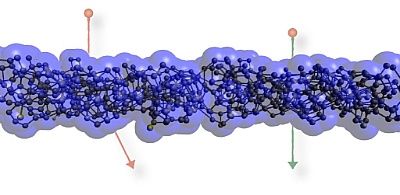Nanomaterial outsmarts ions
Ions are an essential tool in chip manufacturing, but these electrically charged atoms can also be used to produce nano-sieves with homogeneously distributed pores. A particularly large number of electrons, however, must be removed from the atoms for this purpose. Such highly charged ions either lose a surprisingly large amount of energy or almost no energy at all as they pass through a membrane that measures merely one nanometer in thickness. Researchers from the Helmholtz-Zentrum Dresden-Rossendorf (HZDR) and Vienna University of Technology (TU Wien) report in the scientific journal Physical Review Letters that this discovery is an important step towards developing novel types of electronic components made of graphene.

The left ion in the diagram is deflected by a collision with an atom in the membrane, which is only one nanometer thick and loses considerably more energy than previously believed (red arrow); the right ion passes virtually unhindered through the membrane (green arrow).
HZDR
Although highly charged ions cause damage only on a very limited area of a material surface, they do so extremely efficiently. This makes them an ideal tool for special tasks, such as perforating ultra-thin films of carbon that measure only one nanometer in thickness (one nanometer = one millionth of a millimeter). The result is a technologically usable nano-sieve that could, for example, separate different gases.
“Bombarding material with ions can be compared with striking billiard balls,” according to Richard Wilhelm, doctoral candidate at the HZDR. “A professional player knows exactly at which angle he must strike the ball in order to succeed during his turn. In doing so, the player also calculates the energy that must be transmitted by a ball to one or more of the other balls.” Ions behave similarly when they collide with atoms in the material. The ions gradually slow down on their path through a large number of collisions and continuously lose energy — like a bullet that penetrates a tree trunk and then comes to rest there.
For an ultra-thin material that consists of only a few atomic layers, this analogy, however, is not applicable — as the exciting results demonstrate from the latest experiments at the Ion Beam Center of HZDR. Wilhelm and his colleagues from Dresden and Vienna observed for the first time in experiments that the highly charged ions either flew through a nanomebrane virtually unaffected, or lost an astounding amount of energy in doing so. It was previously assumed, however, that ions always lose the same amount of energy on average.
In order to see this newly discovered effect at all, the membrane cannot be thicker than one nanometer — the carbon membrane, hanging freely from a carrier, was produced at the University of Bielefeld. In addition, the ions must have a high positive charge, meaning that many electrons were removed in advance. Thirty-fold charged xenon ions were used. Two different events can occur when the xenon ions hit the ultra-thin membrane. While one ion can virtually pass unimpeded between carbon atoms of the nanomembrane, a different ion might collide with one of the atoms in the material. During such a collision, it passes through the electron cloud of the atom and sucks up the negatively charged electrons. This electron capture almost leads to neutralization of the ion, resulting in a considerable deceleration. Depending on the angle at which the ion continues to travel after the collision, the energy loss amounts up to ten percent.
“Our experiments demonstrated for the first time that the energy loss in the material depends considerably on the charge state of the ions. We suspect a general relationship, which could not be previously observed with the customary thicker materials and in lower ion charge states,” explains HZDR doctoral candidate Wilhelm.
Graphene the “miracle material”
The researchers at the Helmholtz-Zentrum Dresden-Rossendorf and Vienna University of Technology (TU Wien) would like to work with the promising material of graphene as a next step. Graphene is carbon that is only one atomic layer thick. It possesses almost exotic properties, such as extreme durability while it is also transparent and a metal. “Many groups around the world are working with graphene at the moment, but only very few are incorporating foreign atoms into the two-dimensional material. If this could be done routinely using ion implantation, it could lead to novel electronic components with unexpected capabilities,” explains Richard Wilhelm. Within the Ion Beam Center of the HZDR, several more facilities are available for generating highly charged ions for experiments with graphene. The TU Wien, a long-term research partner, is again actively on board.





























































